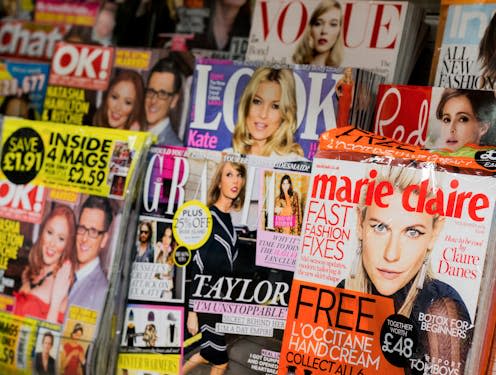Loaded: one of the biggest lads’ mags returns – these are the challenges it will face

Tell the lads. After a nine-year hiatus, Loaded magazine is back. Actually, don’t tell the lads, tell their dads. According to executive director Danni Levy the relaunch is to target the original buyers, only now they’re “living happily at home with their wife and kids”.
The magazine brand that blew apart political correctness in the 1990s and 2000s claims that it will “flip the middle finger to modern ideas about men” in a new, digital-only format branded as Loadedworld. Actress and model Liz Hurley is featured on the cover of the relaunch, just as she was for the first-ever issue back in 1997.
Much of the media reception has been scathing. It has been called “the saddest relaunch in history”.
In interviews, Levy has played the rebrand into both sides of the culture wars, claiming that modern men need a safe space between the “attitude that no one can say or do anything” and the tsunami of online pornography that is “giving youngsters a warped idea of sexual normality”. In other interviews Levy admits that the updated brand will not contain any nudity, focusing instead on tech, sport, films and fashion journalism to target a more mature audience that is jaded with porn but has no dedicated platforms for men.
While Levy astutely got the media into a lather over the return of political incorrectness, the official press release for the re-launch is more nuanced and claims that the magazine will chart a new space for men that is neither “toxic” nor “super safe”.
There is certainly a market for nostalgia, and middle-aged men are amongst the most ardent consumers. Whether comparing their vinyl record collections or riding vintage bikes, such communities can often embrace past icons and challenge current culture.
Whether there are men out there, knee-deep in nappies and pining for Loaded magazine, remains to be seen. Meanwhile, the relaunch faces other challenges in a tense environment for media brands. If the print version of Loaded crashed and burned, why would a digital revamp do any better?
There’s no doubt that digital advertising will continue to dominate the media market. It is seen as cost-effective and measurable, and an ever-increasing proportion of advertisers’ budget is shifting from traditional media to digital formats such as podcasts, search, social, digital out-of-home and on-demand video.
American retail entrepreneur John Wanamaker famously said that half the money I spend on advertising is wasted- the trouble is, I dont know which half. For advertisers, digital appears to solve that problem, because they have the data.
Risks of a digital launch
Today’s media landscape for print brands is unforgiving. After almost 200 years breaking world headlines, the London Evening Standard is to follow many newspaper brands by ending its daily print edition. The Standard had gone to a freesheet model and still couldn’t attract enough advertising revenue to cover its costs.
Even for iconic magazine brands, the shift to digital is fraught with risk. The relaunch of legendary music magazine Q was suddenly (and mysteriously) cancelled after barely six months. Just because a media brand has a nostalgic connection with its audience, it doesn’t mean that will translate to a digital offer that makes money by attracting advertisers.
So, what is the business model that works for media brands?
Some news brands have navigated the shift online with dexterity. The New York Times, The Guardian and Daily Mail are three of the most visited news websites in the world. But all digital media brands face a choice – give their content away free and sell advertising around it, or charge for it. Both carry risk.
Reach, owner of dozens of UK regional news titles along with the Daily Mirror and Daily Express, has really struggled with its online user experience. It’s been criticised for overloading advertising on pages with endless pop-ups, and is currently laying off staff.
Another UK brand, the Times, chanced its arm by imposing a paywall in 2010. Its success has shown that its readers are prepared to pay for exclusive content. Meanwhile, the Mail has recently introduced a compromise model. The company charges £4.99 a month to get access to Mail+ articles, and claim to have signed up more than 150,000 readers so far.
Loaded’s backers have learned these lessons and are banking on a subscription model, with just enough free content for readers to try before they buy. Readers can get three months free membership, after which there’s a charge of £9 a month.
The old strapline, “For men who should know better” is updated without the “should” and the more mature content is a backhanded compliment to those hard-pressed dads.
The brand is suggesting its readers have grown up, and so has their favourite magazine. Time will tell if those dads will shell out their hard-earned money for the experience. Six months ought to do it.
This article is republished from The Conversation under a Creative Commons license. Read the original article.

The authors do not work for, consult, own shares in or receive funding from any company or organisation that would benefit from this article, and have disclosed no relevant affiliations beyond their academic appointment.

 Yahoo News
Yahoo News 